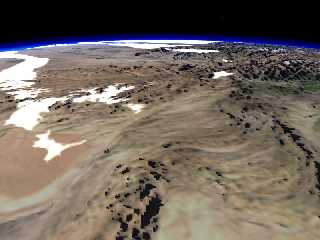|
 |
High!
After the disillusioning attempts at building spherical meshes from
heightfields, I tried out Christoph Hormann's Iso_CSG library, which
also contains several iso_hf functions - and it works perfectly, parsing
is no longer a big issue, instead rendering itself is much slower... but
at least, it's interruptible!
Firstly I started with guess what...
...right, Afghanistan of course! This picture shows the country from a
400-kilometres low earth orbit (or LEO, as we space geeks prefer to
say!); the atmosphere is a sphere 50 kms wider than Earth itself, filled
with a repeating media density spherical pattern (the frequency is set
to (Earth_Radius+Atmosphere_Height)/Atmosphere_Height), using also a
color_map
ranging from deep blue to light cyan.
The coulds also are media which fills a thin shell between 4 and 10
kilometres above ground. Provisionally, I used a granite pattern with
turbulence 0.9 and scaled it to 3000 to avoid too small-spaced clouds.
But apart from the fact that many mountains tower above the cloud deck
(because of the low horizontal resolution of the topographical Earth
heightfield - only 10,800 by 5,400 pixels - I exaggerated the relief by
factor 2.5), there are several questions:
1) With granite, I get more or less narrow long bands of clouds, but not
the tell-tale cyclone eddies of the temperate latitudes; also I'm not
able to control the cloud distribution in a way that over deserts you'd
see less clouds or, on the other hand, thick cloud banks at mountainous
western higher-latitude shores like British Columbia, Norway, southern
Chile or New Zealand.
Can this be done with warps - or do I have to model entirely new
functions, perhaps loosely based on models brought up by climate
research?
2) The clouds appear too bright, especially when considering the low
illumination angle in this scene (it's noon at Greenwich, therefore
about 4 o'clock PM (solar time) in Afghanistan). But decreasing the
scattering color value would make them become semi-transparent. Is there
a way to make the clouds darker without losing their opacity?
3) Despite the clouds' thickness being visible at the horizon, the
clouds in the foreground appear flat, without any internal structure.
Can this be changed still with media, or do I have to use isosurfaces?
4) I wonder that the clouds don't cast any shadows, even though I did
not add no_shadow to the clouds' container shell... is this a general
flaw of media?
By the way, the starry sky is a sky_sphere with an object texture; the
star's sizes and coordinates are taken from a popular German sky atlas,
the famous-infamous "Karkoschka"... it's not complete yet, so there are
not many stars visible in this direction.
See you in Khyberspace!
Yadgar
Now playing: Heart of the Sunrise (Yes)
Post a reply to this message
Attachments:
Download 'afghanistan_from_leo_bozo_media_clouds.jpg' (80 KB)
Preview of image 'afghanistan_from_leo_bozo_media_clouds.jpg'

|
 |




![]()